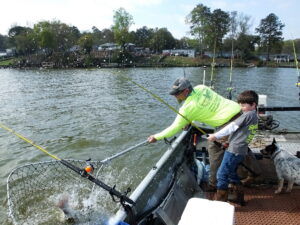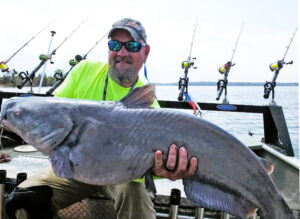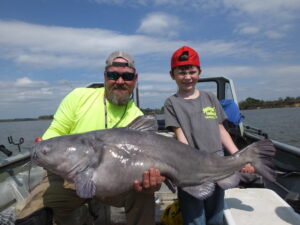Professional catfishing guide and tournament angler Scott Peavy says moving
water creates ideal opportunities to catch fat cats in skinny water.
Fat Cats in Skinny Water
by Terry Madewell
Anglers looking for fast-paced action on active, biting fish should check out the skinny-water options this spring. It’s not just for numbers of fat cats. It’s prime time for trophy catfish, too.
March weather creates a major transition from the cold water of winter to the warming water of spring. As water temperatures rise, forage patterns morph toward the shallows, and savvy anglers know catfish will follow.
Some anglers embrace this as an opportunity to take fat cats out of surprisingly skinny water.
Scott Peavy, 44, from Blythewood, South Carolina is a USCG-licensed fishing guide and a successful catfish tournament pro. He guides on multiple lakes throughout the region and also works as a tournament official for the KingKat Tournament Trail, enhancing his insight to developing shallow-water fishing patterns from a national perspective.

“Catfish are creatures of habit, and the number-one habit is they love to eat,” Peavy said. “Not all catfish are going to be in skinny water during the spring, but as the water warms and forage floods into the shallows, plenty of catfish are going to move shallow, including trophy fish. I think this presents an underutilized opportunity.”
Peavey has developed strategies that enable him to find biting catfish in skinny water throughout much of the year, and certainly during March and through the spring.
“It’s about having forage, and the right physical conditions in shallow water, to attract and hold catfish,” he said.
Peavy (803-569-7917) said multiple shallow-water patterns exist. Fishing moving water is an excellent choice because both forage and catfish are attracted to this environment.
“Catfish and current fit like hand in glove, and this productive year-round pattern is common during spring,” he said. “Current occurs in various situations, and heavy rains create current in the upper end of lakes and rivers, and in large tributaries. In many of the lakes I fish, this locally increased current creates an excellent catfishing opportunity in shallow water, especially when it produces discolored water.”
This improved fishing pattern exists for a finite time during periods of unusually heavy water flow, but quantity and quality catfish flood into these hotspots.
Peavy said in addition to rivers and lakes, many anglers around the country have access to tailwater areas below a dam that produces moving water. These areas attract various forage species as well as catfish.
Peavy scans the underwater topography with his electronics to pinpoint forage and fish, then he set up to fish a specific target. He usually anchors in the shallows but near a drop into deeper water.

“I’ll fish multiple rigs with bait native to that specific water system,” he said. “I’ll give an area 30 minutes, and if I don’t have the action I expect, I’ll move. Generally, catfish in shallow, moving water are feeding fish, so I don’t linger unless I’m catching fish.”
Peavy said another successful tactic he employs is targeting big catfish that homestead in slightly deeper holes in the back of creeks and coves.
“This is a situation where big catfish can be targeted effectively when forage floods into the shallows as the water warms,” he said. “Depressions, or a deeper ditch coursing through a shallow flat, provide the slightly deeper water need to attract forage. I believe big catfish often establish long-term residence in these areas.”
While these areas can be large, Peavy said the actual target for catching catfish is often small.
“I’ll target these slightly deeper areas located with my electronics,” he said. “I’ll slip in quietly and fish from an anchored position. This pattern is best in low-light conditions and is often my first option to begin the day.”
The bite is often aggressive, and it’s common to have fish hooked before he gets all of his rigs deployed.
“Thirty minutes is ample time to fish this area unless I’m catching fish,” he said. “If I catch a couple cats quickly and the action slows, I’ll make a move to a similar area while the light is low.”
Many lakes provide shallow-water fishing opportunities far from the shoreline that produce underutilized shallow-water action.
“Mid-lake humps and high spots along river or creek channel ledges are ideal for big catfish,” he said. “Shallow-water humps and channel ledges dropping into deeper water are prime targets throughout the day.”

Peavy said these targets can be shallow, only three to 10 feet deep in most of the lakes where he guides. But the definition of shallow water will vary with the type lake being fished, and in deep, clear lakes, the literal depth number may change but not the concept.
Peavy said the larger targets can be drift fished, but if the target is small, he’ll generally anchor in slightly deeper and cast baits to the shallow water.
He said often the best bite for the biggest catfish will be quite shallow. He’ll fish the target for 20 to 30 minutes because, if fish are present, they’re usually looking for food.
Wind is often considered a deterrent to success during spring because it can impair boat control, complicate bait presentation and, in extreme cases, can dictate where anglers can fish.
“But the March wind can be a catfisherman’s friend,” Peavy said. ‘Windblown shallow flats and points have the potential to produce extraordinary action.”
High winds tend to push forage into downwind areas such as flats, points or coves, creating a feeding bonanza. The wind often creates the advantage of a mud or dingy waterline in the shallows.
“The dingy or muddy water makes it conducive for huge cats to get in skinny water, but you’ve got to seize the opportunity while available,” he said. “The target area to fish is usually shallow, but the most productive scenarios have deeper water nearby. This a prime opportunity to hook a super-sized cat in skinny water.”
Peavy said safety is paramount, so understand, and respect, the capabilities of your watercraft.
“Every lake or river situation is unique, so I don’t hesitate to modify these tactics to adapt to local, existing conditions,” he said.
Catfishing in skinny water is a topic many anglers discuss, but few truly embrace the concept. Catfish may be caught throughout the water column, but during March, targeting skinny water with the right tactics can lead to an abundance of fat cats.
(Terry Madewell hails from Ridgeway, S.C. and has been an outdoor writer for more than 40 years. He holds a degree in Wildlife and Fisheries Management and has a long career as a professional wildlife biologist/natural resources manager. He is passionate about sharing outdoor adventures with others.)





